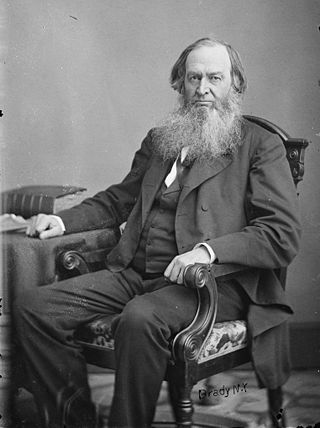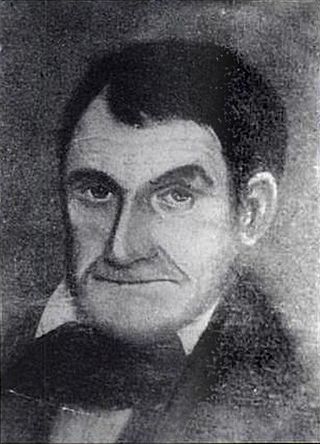
John Brown was a prominent leader in the American abolitionist movement in the decades preceding the Civil War. First reaching national prominence in the 1850s for his radical abolitionism and fighting in Bleeding Kansas, Brown was captured, tried, and executed by the Commonwealth of Virginia for a raid and incitement of a slave rebellion at Harpers Ferry in 1859.

Russell Earl Banks was an American writer of fiction and poetry. His novels are known for "detailed accounts of domestic strife and the daily struggles of ordinary often-marginalized characters". His stories usually revolve around his own childhood experiences, and often reflect "moral themes and personal relationships".

Mary Ann Day Brown was the second wife of abolitionist John Brown, leader of a raid on Harpers Ferry, Virginia, which attempted to start a campaign of liberating enslaved people in the South. Married at age 17, Mary raised 5 stepchildren and an additional 13 children born during her marriage. She supported her husband's activities by managing the family farm while he was away, which he often was. Mary and her husband helped enslaved Africans escape slavery via the Underground Railroad. The couple lived in Pennsylvania, Ohio, and in the abolitionist settlement of North Elba, New York. After the execution of her husband, she became a California pioneer.

Gerrit Smith, also spelled Gerritt Smith, was an American social reformer, abolitionist, businessman, public intellectual, and philanthropist. Married to Ann Carroll Fitzhugh, Smith was a candidate for President of the United States in 1848, 1856, and 1860. He served a single term in the House of Representatives from 1853 to 1854.
The Pottawatomie massacre occurred on the night of May 24–25, 1856, in the Kansas Territory, United States. In reaction to the sacking of Lawrence by pro-slavery forces on May 21, and the telegraphed news of the severe attack on Massachusetts Senator Charles Sumner, John Brown and a band of abolitionist settlers—some of them members of the Pottawatomie Rifles—responded violently. Just north of Pottawatomie Creek, in Franklin County, they killed five pro-slavery settlers in front of their families.
The Pottawatomie Rifles was a group of about one hundred abolitionist settlers of Franklin and Anderson County, Kansas, both of which are along Pottawatomie Creek. The band was formed in the fall of 1855, during the Bleeding Kansas period, as an armed militia to counter growing pro-slavery presence: an influx of men known as border ruffians, from the neighboring slave state of Missouri.

Lewis Sheridan Leary was an African-American harnessmaker from Oberlin, Ohio, who joined John Brown's raid on Harpers Ferry, where he was killed.

Owen Brown, father of abolitionist John Brown, was a wealthy cattle breeder and land speculator who operated a successful tannery in Hudson, Ohio. He was also a fervent abolitionist and civil servant, shout and outspoken. Brown was a founder of multiple institutions including the Western Reserve Anti-Slavery Society, Western Reserve College, and the Free Congressional Church. Brown gave speeches advocating the immediate abolition of slavery and facilitated the Underground Railroad.

The John Brown Farm State Historic Site includes the home and final resting place of abolitionist John Brown (1800–1859). It is located on John Brown Road in the town of North Elba, 3 miles (5 km) southeast of Lake Placid, New York, where John Brown moved in 1849 to teach farming to African Americans. It has been called the highest farm in the state, "the highest arable spot of land in the State, if, indeed, soil so hard and sterile can be called arable."

John Brown's raid on Harpers Ferry was an effort by abolitionist John Brown, from October 16 to 18, 1859, to initiate a slave revolt in Southern states by taking over the United States arsenal at Harpers Ferry, Virginia. It has been called the dress rehearsal for, or tragic prelude to, the Civil War.

John Brown Jr. was the eldest son of the abolitionist John Brown. His mother was Brown's first wife, Dianthe Lusk Brown, who died when John Jr. was 11. He was born in Hudson, Ohio. In 1841 he tried teaching in a country school, but left it after one year, finding it frustrating and the children "snotty". In spring 1842 he enrolled at the Grand River Institute in Austinburg, Ohio. In July 1847 he married Wealthy Hotchkiss (1829–1911), who had also studied at the Grand River Institute. The couple settled in Springfield, Massachusetts, and had two children.

Owen Brown was the third son of abolitionist John Brown. He participated more in his father's anti-slavery activities than did any of his siblings. He was the only son to participate both in the Bleeding Kansas activities — specifically the Pottawatomie massacre, during which he killed a man — and his father's raid on Harpers Ferry. He was the only son of Brown present in Tabor, Iowa, when Brown's recruits were trained and drilled. He was also the son who joined his father in Chatham, Ontario, Canada, when the raid was planned; he was chosen as treasurer of the organization of which his father was made president.

John Henry Kagi, also spelled John Henri Kagi, was an American attorney, abolitionist, and second in command to John Brown in Brown's failed raid on Harper's Ferry. He bore the title of "Secretary of War" in Brown's "provisional government." At age 24, Kagi was killed during the raid. He had previously been active in fighting on the abolitionist side in 1856 in "Bleeding Kansas". He was an excellent debater and speaker.

Charles Turner Torrey was a leading American abolitionist. Although largely lost to historians until recently, Torrey pushed the abolitionist movement to more political and aggressive strategies, including setting up one of the first highly organized lines for the Underground Railroad and personally freeing approximately 400 slaves. Torrey also worked closely with free blacks, thus becoming one of the first to consider them partners. John Brown cited Torrey as one of the three abolitionists he looked to as models for his own efforts.

In the United States, abolitionism, the movement that sought to end slavery in the country, was active from the late colonial era until the American Civil War, the end of which brought about the abolition of American slavery, except as punishment for a crime, through the Thirteenth Amendment to the United States Constitution.

Timbuctoo, New York, was a mid-19th century farming community of African-American homesteaders in the remote town of North Elba, New York. It was located in the vicinity of 44.22°N 73.99°W, near today's Lake Placid village, in the Adirondack Mountains of Upstate New York. Contrary to the information given out by donor Gerrit Smith, who said that the lots were in clusters, they were spread out over an area 40 miles (64 km) north to south, and 15 miles (24 km) east to west.
On Sunday night, October 16, 1859, the abolitionist John Brown led a band of 22 in a raid on the federal arsenal at Harpers Ferry, Virginia.

Watson Brown was a son of the abolitionist John Brown and his second wife Mary Day Brown, born in Franklin Mills, Ohio. He was married to Isabell "Belle" Thompson Brown, and they had a son Frederick W., who died of diphtheria at age 4, and is buried at what is now the John Brown Farm State Historic Site in North Elba, New York.

The abolitionist John Brown was executed on Friday, December 2, 1859, for murder, treason against the Commonwealth of Virginia, and for having led an unsuccessful and bloody attempt to start a slave insurrection. He was tried and hanged in Charles Town, Virginia. He was the first person executed for treason in the history of the country.
















